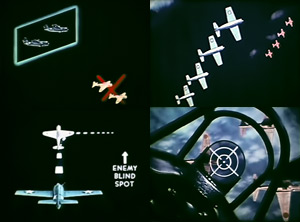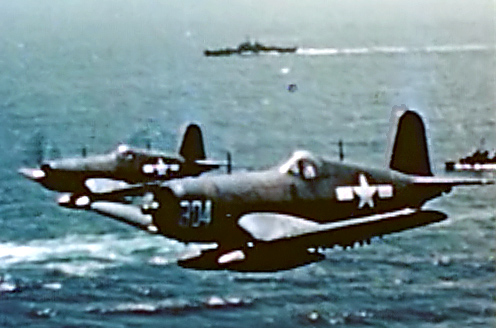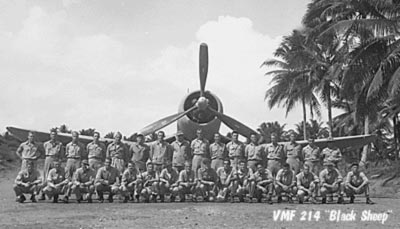- Click here to see More Neat F4U Corsair Stuff Performance charts, cockpit photos, systems diagrams and more from an actual F4U pilot's manual
- -

- Zeno's Take on the F4U
"A big, tough, shipboard fighter." This was the plane flown by Pappy Boyington's infamous "Black Sheep" VMF-214 squadron and VF-17 - "The Jolly Rogers."
Design of the F4U Corsair started in February, 1938, in response to a US Navy call for a new shipboard monoplane fighter. The USN was expecting a plane designed around the latest 1200 hp Wright Cyclone engine, but two divisions of the United Aircraft Company, Vought-Sikorsky (later Chance -Vought) and Pratt & Witney, teamed up to design a revolutionary new fighter around the new R-2800 radial engine, the most powerful engine in the world, projected to develop over 2,000 hp!
The XF4U prototype flew on May 29, 1940. The new plane featured unusual bent "gull" wings, in part to allow more ground clearance for the huge 13 foot Hamilton Standard 3 bladed prop, designed to get the most out of the Corsair's huge engine. When gas tanks were moved from the wings to behind the engine to make room for 6 x 50 caliber machine guns, the cockpit was consequently moved way back to a position 12 ft behind the prop, giving the Corsair it's unmistakable long nosed profile. In October, 1940, the prototype set a fighter plane speed record of 405 mph on a closed course and the Corsair was moved into production, with the first (now 425 mph) F4U-1 reaching the US Navy in July, 1942.
Unfortunately, the new Corsair experienced a plethora of teething problems that delayed its approval for US carriers for almost a year and a half. When landing, her wings did not stall evenly at low speeds (not good on a carrier fighter), vision from the rear set ribbed "green house" canopy was poor, and the "oleo" landing gear struts were too stiff, causing the "Hog," as she was affectionately known to her pilots, to bounce like a tennis ball on a hard landing. The Navy felt these challenges would be too much for the inexperienced new pilots then flooding into the fleet, so the Corsair was not certified for carrier duty, in favor of the more docile, but slower, Grumman F6F Hell Cat. The F4U was instead relegated to Pacific island based Marine and Navy squadrons, as well as for substantial deliveries to the Royal Navy..
The US Navy's carriers loss was the Marines gain. The "Bent Winged Bird" was loved by the island based Marine squadrons who found it to be both an excellent fighter and outstanding ground support bomber, a trait much prized by the Corps. The F4U-1 debuted with VMF-124 as part of the "Cactus Air Force" on Guadalcanal in Oct, 1942, starting combat operations in February, 1943. Effective tactics against the previously dominate Nipponese Zeros were soon developed: keep fast, initiate combat from a superior altitude, don't get sucked into a slow turn fight, and use your superior speed to "boot it on out of there" if you find yourself at a disadvantage. These tactics capitalized on the Corsair's superior speed, excellent dive characteristics, zoom climb qualities and phenomenal roll rate. The F4Us six 50 caliber guns with 400 rounds per gun proved deadly and it soon became clear that she could shrug off much more combat damage than her opponents. The presence of new F4U squadrons was essential in reversing the tide and establishing air superiority over the Solomon Islands, For example, VF-17, flying off Ondonga, shot down an amazing 159 Nipponese aircraft in only 79 days! Known to Japanese pilots as "Whistling Death" for good reason, the F4U had an amazing 11-1 kill ratio during World War II.
Meanwhile, over 500 major running changes were made by the manufacturer to correct faults and improve performance, culminating in the introduction of the F4U-1A in 1943, which incorporated water injection for even more power, a metal strip was added to the leading edge of the right wing to even out her stall, a bubble canopy and raised seat were added to dramatically improve pilot visibility, and revised oleo struts and tail wheel design were incorporated to improve carrier landings.
In 1943-44,the Brits were the first to successfully base the Corsair on carriers, developing an innovative curving landing approach, and the USN's VF-17 "The Jolly Rogers" flew the new & improved Hogs off the Bunker Hill, paving the way for US Navy to finally approve carrier ops. Once back on board, the F4U Corsair was extremely successful. By the end of WWII, the F4U had replaced the Grumman F6F as the USN's number one shipboard fighter and she went on to perform with distinction through the Korean War, and for the French in Indochina.
- Don't miss our bestselling
- F4U Corsair DVD
- Get "Flying the F4U Corsair" plus

- * Offensive Fighter Tactics for Naval Aviators
- (1943, Color, 25:00)
- Learn the tactics US Navy fighter pilot's developed -- the hard way -- during the first two years of the War. Covers everything from situational awareness & assessing enemy capabilities to one-on-one dog fights and squadron tactics. Full of detailed illustrations & examples. A must have for virtual combat pilots and World War II fighter enthusiasts everywhere!
- * Hook Down, Wheels Down
- (1968, Color & B&W, 55:00) Documentary produced by the Department of the Navy to celebrate the first 50 years of carrier based aviation, with an emphasis on World War II. Along with some great Navy action, the highlight of the film are the numerous interviews with famous naval aviators, including John Thatch on inventing the "Thatch Weave."
- * The Saga of the Franklin (1945, Color)
- This inspiring documentary shows how the gallant officers and men of the carrier Franklin overcame incredible battle damage inflicted by a devastating bomb hit to save their ship. Also contains rare and informative color footage of late war F4U Corsair carrier ops and daily life on board the ship.
- * A high resolution reproduction of a 64 page F4U Corsair pilot's manual with photos, systems diagrams, performance charts, flight procedures & more
- If you're a naval aviation fan, stop by Zeno's Flight Shop for the memorable documentary "The Fighting Lady" on our Fighting Lady/Carrier Ops DVD. And there's even more excitement on our new
- US Aircraft Carriers Go to War: World War II Flat Tops in Action DVD!
Vought F4U-1A Corsair Vital Statistics Type: Single seat carrier launched fighter/bomber
Power plant: one 2,000-hp Pratt & Whitney R-2800-8 radial piston engine
Performance
Maximum Speed: 417 mph (671km/h) at 19,000 ft (6065m)
316 mph (509 km/h) at sea level
Initial Climb: 2,890 ft (881m) per minute
Service Ceiling: 36,900 ft (11247m)
Range: 1,015 miles (1633 km)
Weights: Empty: 8,982 lb (4074 kg)
Loaded: 14,000 lb (6350kg)
Dimensions
Span: 41 ft (12.5m)
Length: 33 ft 4 in (10.16m)
Height:16 ft 1 in (4.9m)
Wing Area: 314 sq ft (29.15m2)
Armament
6 X 0.5 (12.7mm) machine guns
Bomb Load (F4U1-D): 2,000 lb (1818 kg)
- -
- F4U Corsair DVD




